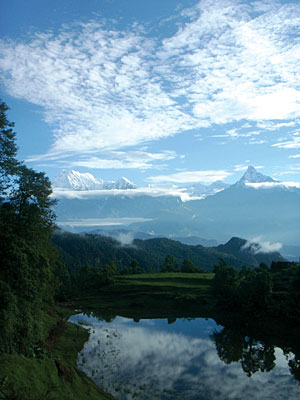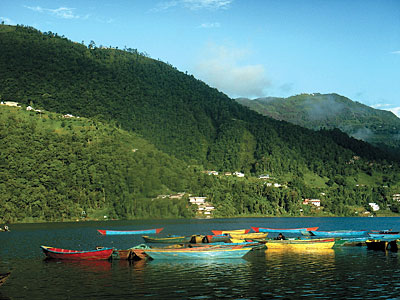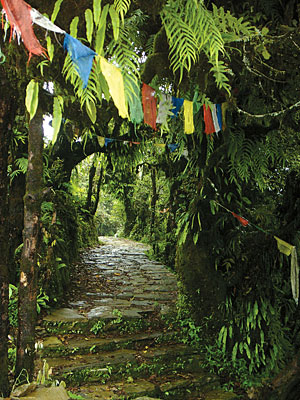Don't believe the guide books. Visit Nepal in the monsoon, especially Pokhara the part of Nepal with the highest annual rainfall.
Last week, as expected, Pokhara's lakeside was deserted. It is supposed to be the "off" season. Besides fewer tourists, the town's adventure sports facilities also close down: paragliding, ultra-lights, rafting and trekking. Despite the erratic monsoon, however, there is nothing to match the greenery at this time of year. And when the Annapurnas make an appearance through clouds they have a ghostly monochromatic light that you don't see any other time.
Even besides off-season discounts and delicious mangoes, the monsoon has a lot to offer that can only be enjoyed during this special time of year. So let's explore Pokhara and its beautiful surroundings for its wet season instead of trying to avoid the rain. It only takes a change in attitude and some precautions to enjoy a (quite literal) dip into the monsoon experience. Bring proper rain gear, tablets against diarrhea, mosquito repellent, sun block, salt or chewing tobacco against leeches and a willingness to get wet. Once prepared, a three to five day trek around Phewa Lake to Panchase provides visitors with an opportunity to soak in the beautiful scenery and greenery special to the monsoon. Panchase has the highest precipitation rate in Nepal, even more than Ilam.
Roads less traveled due to the small number of fellow hikers will (as one experienced trekking guide put it) 'make you feel like you're actually in the mountains again'.Watch farmers carefully plant rice seedlings and enjoy the overwhelming feeling of tranquility and vitality while strolling past the freshly laid out rice terraces glistening in the sun. Over three-fourth of this country's population is involved in agriculture and this time of year the hard work that goes into producing every plate of dal-bhat can truly be understood and appreciated. Further up, one enters the abundant greenery and mystical light of Panchase's cloud forests, and its abundant biodiversity.
"Panchase offers over 12 different types of forests and 112 different species of orchids to discover, some of which only bloom during monsoon," says Ram Saran Sedai of the Machhapuchhre Development Organisation. The jungle gives protection from the fierce sun and the raindrops and the abundant waterfalls and ponds serve as cooling bathtubs for cows and buffaloes. Pokhara is so close to the mountains, that you usually get at least one break in the clouds to enjoys majestic views of Machapuchre and Annapurna. Even on good mornings, a few isolated clouds might at first create a 'scenery-problem'. However, you may soon find that the clouds only pay sufficient respect to the magnificence of the mountain ranges, completing the sense of distant mystical grandeur rather than disrupting it. Undeniably, there is something cheerful in the suddenness and strength of monsoon showers to which the colorful and manifold-patterned umbrellas, popping up everywhere with the first drops of rain, only add.
The soft and soothing sound of falling rain is a lullaby helping exhausted trekkers fall into a long and peaceful sleep at night. Learn to love the monsoon as a symbol of rebirth and rejuvenation. The mountains around Pokhara are the best place to see this hidden mystical land in the mist.
 PICS: LISA VON RABENAU AND LISA SCHWOERER |
 |
 |
 |
Bloody leeches
Unfortunately, the monsoon is also the peak season for leeches. Though they do not transmit diseases, leech bites can be irritatingly itchy and precautions are thus advisable. There is no fool-proof method to prevent leech bites, but there are ways to minimise the damage they cause.
For example, leeches supposedly cannot bite their way through nylon stockings and stay away from skin rubbed with soap or chewing tobacco. Personally I find that the smell of chewing tobacco on your legs will not only keep leeches, but also friends away.
Another efficient practice demonstrated to me by Rupesh Gurung in Panchase is tying a cotton bag filled with salt on the bottom of a stick to use the stick to remove leeches from shoes before they get a chance to bite.
Once the blood-suckers have attached to your skin, contact with chewing tobacco or salt will cause them to shrivel up, fall off and eventually die. Another method involves using a fingernail to break the seal of the anterior and posterior ends of the leech, disturbing the suction and causing the leech to remove its jaw.
Chose the right precaution and hope for a relatively bloodless trek.


